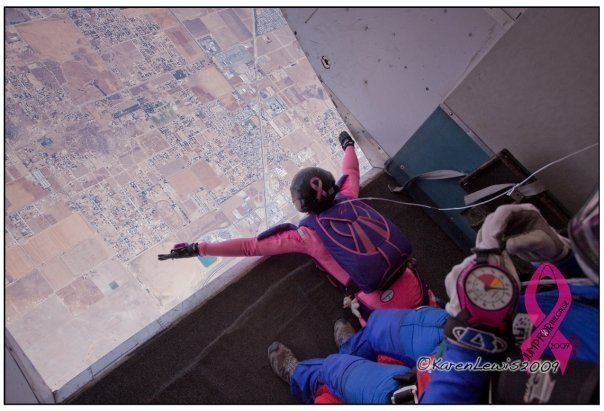Recommended Posts
I asked if he tried kicking the other way and he looked at me confused. Then he told me I shouldn't teach the kicking tecnique to students because it doesn't work.
*sigh* "
I sincerely Hope that student either gets out of the sport or learns to think in his harness, YOu know what they say, If at first you don't succeed!
BE THE BUDDHA!
QuotePreventing and Curing Line Twists
Line twists have gone from a common nuisance to a common malfunction on small, highly loaded elliptical canopies. There are techniques for reducing the chances of incurring line twists and correcting them if you do get them.
The first step to handling line twists is to prevent them in the first place. The looser the chest strap is the wider the 3 rings will be on deployment, which makes it harder for line twists to develop. Of course, be sure that your harness is secure enough to keep you from sliding out of it. Make sure your leg straps are even. For free flyers, a piece of bungee or elastic between your leg straps will help keep the leg straps from creeping to the back of your knees and keep the risers loaded evenly on deployment. Evenly loading the harness on deployment by keeping your hips and shoulders level with the ground will help keep the canopy opening on heading. A pre-mature brake release can easily cause line twists and limits your ability to steer away from others immediately after deploying. When stowing the lines on the deployment bag, keep the stows neat and even. Refer to your owner's manual or call the manufacturer for the correct size rubber bands. Leave 12 to 18 inches of excess line between the side with the least amount of excess and the corner of the reserve container. This will prevent the lines from hanging up on the reserve container and twisting the deployment bag as it leaves the container. A worn out pilot chute can spin on deployment, which can spin the deployment bag. Replace a pilot chute that has holes in the fabric or tears in the mesh. Re-line a canopy that is out of trim. If one end cell “A” line has shrunk more than the opposite side, the canopy will open turning in the direction of the shorter line. Also, if one steering line has shrunk more than another or has excessive twists in the line, the canopy will want to turn in the direction of the shorter line on opening. Take care when setting the brakes of your canopy and take out any twists in the steering lines, which shorten the line. Pulling the slider down to the 3 rings can prevent self-induced line twists and most importantly, smooth control inputs.
Even if you take all possible precautions, line twists still happen. If you find yourself under canopy with line twists and the canopy is flying straight, simply kick out of the twists. Make sure you are kicking in the right direction. You can also twist the risers to bring the twists closer to you and reach above the twists for leverage to get yourself out of the twists.
Let's say that you weigh 170 lbs. And that when you open, you have 60% of your weight on one leg stap and 40% on the other. So the harness shifts on opening, so that the links are not even. The canopy begins to spin, creating spinning line twists, i.e. harness steering. As the spin rate increases, so do the "G" forces. Initially you had 102 lbs. (60% of 170 lbs.) in one leg strap and 68 lbs. in the other leg strap, a 34 lb. difference. Now, because of the spinning, you are pulling 2 "G"'s. Now in one leg strap there is 204 lbs. and 136 lbs. in the other, a 68 lb. difference.
If the canopy is spinning with line twists, react quickly, look up at your links and make them even by shifting your weight in the harness. Be careful not to overdo it and cause the canopy to spin in the opposite direction. At the same time, make sure your brakes are still set. You can use any reference you want, but I’ve found using the links to make the risers even is easiest. The canopy should stop spinning and fly straight. Now kick out of the line twists. Again, make sure you are kicking in the right direction. A canopy that is spinning in line twists loses altitude rapidly. It is critical to maintain altitude awareness. If you are on your back, it is because as the canopy opens and you sit down into the harness, you are in a de-arched and stable back-to-earth free fall position. The speeds generated by a spinning canopy can be close or even overlap with free fall speeds. The same aerodynamics forces that would put you back-to-earth in free fall will put you back-to-earth under a spinning canopy. Remember under a highly loaded elliptical, you don’t have much time depending on your pull altitude and you do not want the twists to include the excess cutaway cable in the back of your risers. This can make for a difficult or impossible cutaway. Riser inserts have been proven to reduce the pull force during a cutaway from line twists.




Imagine jumping into the air and kicking your legs around so that you're facing 90 degrees left or right. Kind of like doing the twist, if you're old enough to remeber that.
Another way to think of it would be to kick so that you're trying to turn your bellybutton against the line twists.
F'rinstance, if you were kicking left, you'd kick your right leg around the front to the left, and your left leg back and around to the right. turning your bellybutton into the twist.
I love you, Shannon and Jim.
POPS 9708 , SCR 14706
Share this post
Link to post
Share on other sites